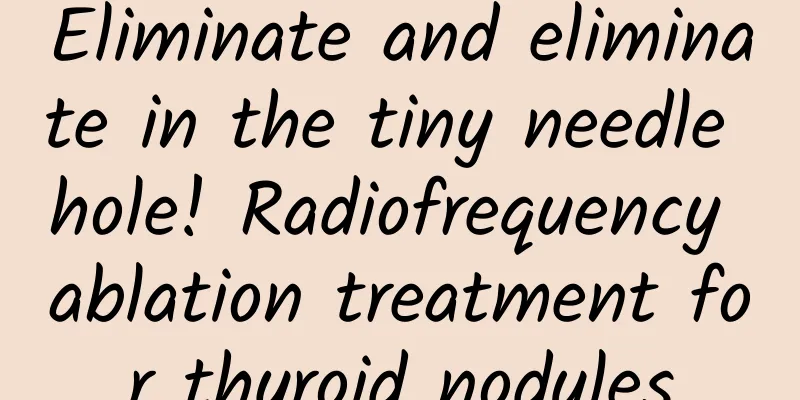Eliminate and eliminate in the tiny needle hole! Radiofrequency ablation treatment for thyroid nodules

|
Qinhuangdao First Hospital Guo Shuai I had a nodule on my thyroid gland , and the ultrasound department solved it with just a "needle" Ms. Li (pseudonym), 38 years old, is a middle school teacher. Her unit arranges a physical examination for her every year. During this year's physical examination, Ms. Li was found to have a nodule on her thyroid gland, which scared her a lot. For the past two days, she kept wondering if she had thyroid cancer, so she rushed to our hospital for a follow-up examination. The color ultrasound examination report showed that Ms. Li had a 6*5*6mm low-echo nodule in the right lobe of her thyroid gland, with dot-like strong echoes inside. Ultrasound suggested a nodule in the right lobe of the thyroid gland, C-TIRADS 4A category. Puncture was recommended, and ablation treatment was performed if necessary. Ms. Li panicked: "Oh no, they notified me to have surgery, it must be cancer! The scar left on my neck will be so ugly!" Just as Ms. Li was anxious, the doctor suggested that she could consider "radiofrequency ablation of thyroid nodules" by the Department of Ultrasound Medicine. What? Ultrasound medicine can perform surgery? This sounds quite new. After the doctor patiently and carefully explained the advantages of the surgery, Ms. Li's heavy mood was relieved, as if she had found her backbone and had great hope for recovery. Soon, under the leadership of the director of the Ultrasound Medicine Department, the surgical team carefully evaluated the patient's general condition, carefully studied the characteristics of the lesions, planned the needle insertion route, and determined that the surgical process would be divided into four steps: the first step was preoperative angiography to determine the internal blood supply of the lesion and the location and size of the lesion; the second step was ultrasound-guided injection of a proportioned solution to isolate the nodule from the surrounding tissue; the third step was ultrasound-guided radiofrequency ablation; and the fourth step was immediate postoperative ultrasound angiography to determine whether the ablation was sufficient. The detection rate of thyroid nodules in the population is 20% to 76%, of which malignant tumors account for 7% to 15%. Currently, the main treatments for thyroid nodules include follow-up observation, surgery (including traditional open surgery and laparoscopic surgery with small incisions and cosmetic effects), and ultrasound-guided ablation therapy. Among them, ultrasound-guided ablation therapy is currently a minimally invasive thyroid treatment method recommended in mainstream guidelines at home and abroad. Diagnosis and treatment in one So you are such an ultrasound specialist. By only inserting a needle into the body, the tumor lesion can be ablated, and the prognosis is good. How is such a magical operation accomplished? Ultrasound-guided radiofrequency ablation is a new technology for treating tumors in recent years. It uses a needle, namely a radiofrequency needle, to be accurately inserted into the tumor tissue under ultrasound guidance to produce "thermal coagulative necrosis" . It has the advantages of being safe and effective, with less trauma, rapid postoperative recovery, and maximum retention of normal tissue. In the past, the ultrasound medicine department that everyone was familiar with was for examinations, such as abdominal color ultrasound, obstetrics and gynecology color ultrasound, vascular color ultrasound, thyroid color ultrasound, breast color ultrasound, etc., which often only had a diagnostic function. In clinical practice, diseases were mainly discovered and diagnosed by imaging images. As ultrasound technology becomes more and more advanced, interventional ultrasound has gradually come into everyone's view. Its main principle is to use ultrasound images to "navigate" in real time under the monitoring and guidance of ultrasound to complete operations such as puncture biopsy, aspiration, catheterization, and injection of drug treatment for various lesions, thus playing a role in integrated diagnosis and treatment in clinical practice. What is ablation therapy In layman's terms, a needle slightly thinner than a pencil lead is inserted into the nodule under local anesthesia. The puncture needle tip generates heat to "burn" and kill the tumor cells. Advantages of ablation therapy Ablation therapy is minimally invasive, and there is no surgical incision on the neck, so there will be no scars after treatment. In addition, because ablation therapy does not remove thyroid gland tissue, it can preserve the gland function after the tumor is resolved, and there is no need to take medication for life after surgery. What kind of thyroid nodules Ablation therapy may be an option Not all thyroid nodules can be treated with ablation. Indications must be strictly selected. Generally, ablation can be used in the following situations: (1) Benign nodules confirmed by fine needle aspiration are larger than 3 cm and have local compression symptoms that affect breathing, swallowing, or neck aesthetics; (2) The nodule is larger than 2 cm and continues to grow; (3) Microscopic papillary thyroid carcinoma with a diameter of less than 1 cm in a suitable location and no cervical lymph node metastasis; Ablation of thyroid nodules How effective is it? In regular thyroid nodule ablation treatment, ultrasound angiography is performed before, immediately after, and at different times after surgery to evaluate the ablation range. Generally, some microcancers will be absorbed by themselves in about 12 months, and benign nodules will shrink to varying degrees in about 12 months. Literature reports that after 3 years of follow-up after treatment of benign nodules, the nodule volume reduction rate is 66.9% to 97.9%. However, because patients have individual differences, the treatment effect will be related to the person's immune status and the specific situation of the nodules. |
<<: Beware! This thermos cup turns hot water into "toxic water", and some people still use it
>>: Surprising discovery! China's obesity map is released, people in these places should be alert!
Recommend
Caesarean section for second pregnancy pain
If you want to have a second baby after a cesarea...
How to supplement food after abortion
Abortion is also called artificial abortion. It r...
What is the easiest way to shrink vagina?
For female friends who want to tighten their vagi...
Why is the discharge black when my period comes?
The color of menstrual blood has always been a pr...
Do you really know about occupational diseases?
What are the types and hazards of occupational di...
Which fruits and vegetables are in season and healthy in spring?
March is the month of spring again. The grass is ...
Is breast pain during pregnancy normal?
When women enter the pregnancy stage, their breas...
What kind of honey is best for women?
Honey is a rare treasure in the world. Why do som...
Decoding DBA: The truth about rare anemia in infants and young children
Author: Han Bing, Chief Physician, Peking Union M...
How many months does it usually take for pregnant women to start taking calcium supplements?
Calcium supplementation is a particularly importa...
What can't you eat during abortion?
After many people have an abortion, the damage to...
What to do with moderate uterine prolapse
The uterus is a relatively important reproductive...
Looking down at your phone every day = your cervical spine is "supporting" more than 50 kilograms of rice!
Li Bing (pseudonym), 19 years old, doesn't li...
Is it true that not washing your face in the morning is good for your skin? What causes nosebleeds when you wash your face in the morning?
Our daily basic skin care habit is to wash our fa...
Will purulent leucorrhea heal on its own?
The appearance of leucorrhea may be due to physio...









